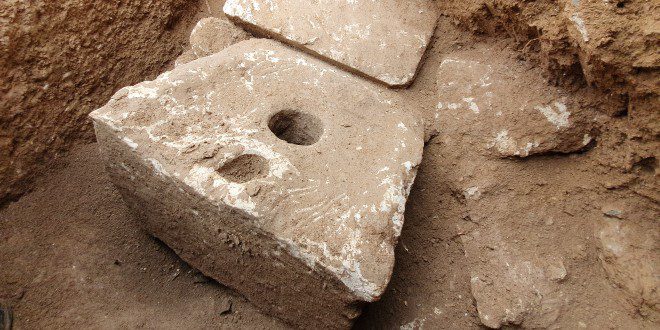A rare toilet cubicle from the First Temple Period, which was part of an ancient royal estate that operated at the end of the Kings of Judean period (7th century BCE), was discovered on the Armon Hanatziv promenade in Jerusalem, where the Israel Antiquities Authority and the City of David, about two years ago, uncovered the remains of a magnificent building which overlooked the City of David and the Temple Mount, including the private toilet cubicle.
The bathroom was hewn as a rectangular-shaped cabin, with a carved toilet, which stood over a deep-hewn septic tank. The toilet, made of limestone, is designed for comfortable sitting, with a hole in the center. According to Yaakov Billig, Director of the Excavation on behalf of the Israel Antiquities Authority, “A private toilet cubicle was very rare in antiquity, and only a few were found to date, most of them in the City of David. In fact, only the rich could afford toilets. A thousand years later, the Mishnah and the Talmud raised various criteria that defined a rich person, and Rabbi Yossi suggested that to be rich is “to have the toilet next to his table.”
Beneath the toilet, a septic tank was discovered, containing a large amount of pottery from the First Temple Period and animal bones. The finds were carefully collected, including the soil fill. Their investigation may teach us about the lifestyles and diets of the First Temple people, as well as ancient diseases.
Impressive architectural items were discovered in the excavation, including stone capitals designed by an artist, bearing a style typical to the days of the First Temple, and small architectural columns that served as railings for windows.
Archaeologists also identified evidence that a garden with ornamental trees, fruit trees and aquatic plants was planted near the toilet cubicle. All of these allow researchers to recreate
a picture of an extensive and lush mansion, apparently – a magnificent palace from the days of the First Temple, that stood on the site.
According to Eli Eskosido, Director of the Israel Antiquities Authority: “It is fascinating to see how something that is obvious to us today, such as toilets, was a luxury item during the reign of the kings of Judah. Jerusalem never ceases to amaze. One can only imagine the breathtaking view. I am convinced that the glorious past of the city will continue to be revealed to us in the future and will allow us to experience and learn about our past.”
The discovery will be presented tomorrow (Wednesday) at the conference “Innovations in the Archaeology of Jerusalem and its Surroundings,” which will last two days and will take place in Jerusalem and on Zoom. Details of the event is on the Facebook page of the Israel Antiquities Authority.
The new tourist complex located at Armon Hanatziv is the result of a collaboration between the City of David, the Ministry of Tourism, the Jerusalem Municipality, the Ministry of Jerusalem Affairs and the Jewish National Fund.
The shortcode is missing a valid Donation Form ID attribute.




